
|
Sale 80
June Pre Long Beach Sale
| Lot |
Photo |
Description |
Realized |
Lot 1944 |
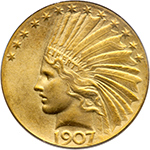 |
1907. Wire rim, periods. PCGS graded MS-65. A hint of golden toning. A very popular key date. Housed in an Old Green Holder. Only 500 struck. Numismatists consider 1907 to be a watershed year in American coinage innovation. Tossed aside as outdated were several middle-of-the-road coin designs that had outlived their purpose. President Theodore "Teddy" Roosevelt, spearheaded the revolution. Wielding his authority, he forced the Mint to bring its coinage design up to twentieth century standards. This was an time when politicians and statesmen were flexing the government's muscles, so to speak. The United States� brand-new navy, christened the Great White Fleet, was steaming on a world tour as sort of a chest-pounding exercise. What we were telling the other great powers was that America, too, was a power to be reckoned with in the imperial age; America, too, could throw its iron muscle around; America showed that it had the wherewithal to defend its territorial interests. Regardless of one's opinion of nationalism, Theodore Roosevelt exemplified it and was in the vanguard of this American thinking. These elegant Ten Dollar Pieces by Augustus Saint-Gaudens were one of the more visible responses to this modernization program, and should be cherished as others cherish artifacts from prior, historic openings.
The Wire Edge $10 is one of a mere 500 pieces made without intentions of circulation, technically making the Wire Edge ten a pattern (Judd-1774). This issue was the closest the mint came to reproducing the ten-dollar design as conceived by Augustus Saint-Gaudens and Theodore Roosevelt. The presently offered coin has subtly variegated coloration, pristine satin-like field and devices, and only the most trivial of marks, none of them which are important. The die polishing swirls (common on all specimens) are a little more pronounced on the reverse fields than the obverse, while overall the coin has a bright satiny sheen. A bold Gem coin.
Originally, Saint-Gaudens wanted President Roosevelt to authorize the use of a standing figure, but the President preferred a head on the gold Eagle, feeling that the heroic effect of any standing figure, as chosen for the double eagle, would be lost in smaller diameter. The profile the artist chose originated in a figure of Nike ('Victory'), part of his Gen. Sherman Monument (1905), ultimately inspired by a Hellenistic Wingless Victory on the temple of Zeus Soter. At Roosevelt's insistence, and for no other reason, Saint-Gaudens gave this head a nationalistic character by the adding a feathered war bonnet, such as neither Liberty nor any Native American woman would ever have worn. That is how the misleading sobriquet of "Indian head" arises, properly applicable only to Bela Lyon Pratt's 1908-29 half eagles and quarter eagles. (Possibly the war bonnet also served to conceal any connection with the Sherman monument, to minimize protests in the South, puts forward the Breen encyclopedia.)
Saint-Gaudens' standing-eagle device is splendid in its original form, reminiscent of late Egyptian and early Roman work at its best. Pop 58; 26 finer, 4 in 65+, 16 in 66, 6 in 67. (PCGS # 8850) .
Estimated Value $60,000 - 65,000.
View details and enlarged photos
Check results on similar lots
| Realized
$67,563 |
Lot 1945 |
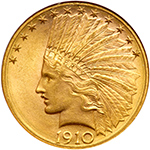 |
1910-D. NGC graded MS-65. Well struck and untoned. Wonderful lustrous surfaces are flourishing with gem quality gold and iridescent brilliance. Exceptional detail for the date. This includes all reverse details present, indeed something reaching "full strike" can be said. Fully struck coins of this year and mint are elusive. Pop 182; 47 finer, 2 in 65+, 33 in 66, 5 in 66+, 7 in 67. (PCGS # 8866) .
The Census for 1910 reported the U.S. population as 91,972,266. An obscure British music-hall performer with a French kick toured the U.S. with a pantomime troupe this year, and appeared in a vaudeville act billed as "Karno's Wow Wows." His name: Charlie Chaplin.
Estimated Value $7,000 - 7,500.
View details and enlarged photos
Check results on similar lots
| Unsold |
Lot 1946 |
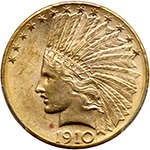 |
1910-D. PCGS graded MS-64. Frosty and untoned, A gold, mint-fresh example, as crisp and glossy, and almost as choice as when it was first released from to the Treasury for distribution. There is one tiny mark on the chin, another on the right leg of the eagle, some more minor abrasions on the forward wing, all really minor. So ends the discussion of the luster. Now on to the detail. This piece is not just close to, but completely and well struck, with terrific detail at the eagle for a D-mint Indian ten in this grade (PCGS # 8866) .
Estimated Value $1,500 - 1,600.
View details and enlarged photos
Check results on similar lots
| Realized
$1,351 |
Lot 1947 |
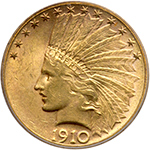 |
1910-S. ICG graded MS-62. Hint of light gold tone and a lustrous example from this Western branch mint. Indian $10 gold pieces featurinig the motto IN GOD WE TRUST were struck from 1908 until 1933. Many were later retrieved by the government from bank, Federal Reserve Bank, and Treasury vaults and melted in 1934-37, however.
Estimated Value $2,500 - 2,600.
View details and enlarged photos
| Unsold |
Lot 1948 |
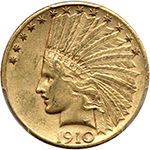 |
1910-S. PCGS graded AU-55. Lightly toned. Lustrous (PCGS # 8867) .
Estimated Value $900 - 950.
View details and enlarged photos
Check results on similar lots
| Realized
$940 |
Lot 1949 |
 |
1911. NGC graded MS-63. Well struck, frosty with light gold tone. A very presentable coin (PCGS # 8868) .
Estimated Value $800 - 850.
View details and enlarged photos
Check results on similar lots
| Realized
$1,175 |
Lot 1950 |
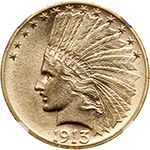 |
1913-S. NGC graded MS-62. Frosty and untoned. Only 66,000 minted. Pleasingly bright and lustrous, both sides are naturally colored in reddish-gold hues. A weak impression was sometimes left by the rebound of the (possibly dilapidated) dies that struck this year�s coinage, but we are delighted to say that this specimen is well struck on all devices, very well indeed. Soft satin luster throughout that is free from marks. Were it not for two minor tics around Liberty�s eye, the entire coin would be devoid of noticeable contact signs. With an original mintage so low, the 1913-S is one of the rarest dates of the Indian Head Eagle series. It is scarce in any grade, but particularly important and desirable in Mint quality like the present offering. Pop 27; 19 finer (PCGS # 8874) .
Background: Augustus Saint-Gaudens' familiarly named "Indian" Head Eagles are more properly his creative talent having to produce a design suited to the political realities caused by Presidential interference. For the 1907-33 eagle design, Augustus Saint-Gaudens (in consultation with President Theodore Roosevelt) decided to use not a standing figure, which the artist preferred, but a Liberty head, the President feeling that the heroic effect of any standing figure, as chosen for the Double Eagle, might be lost in smaller diameter. The Saint-Gaudens 1907 No Motto (and later With Motto) designs were revised by Chief Engraver Charles E. Barber from the earlier Rolled Edge and Wire Edge pieces after the artist's death in Aug. 1907. Barber was forced to do this to improve quality and die life in order for the Mint�s high-speed production coining presses to operate properly. It is Barber�s final interpretation that we see on this lustrous 1913-S $10 gold rarity.
Estimated Value $10,000 - 11,000.
View details and enlarged photos
Check results on similar lots
| Realized
$15,863 |
Lot 1951 |
 |
1914-D. PCGS graded MS-64. Nice shades of golden toning. Well struck. A satiny specimen, right on the cusp of Gem MS65 level, with energetic luster and pleasing color that seems to want to motivate bidders to left their bids as though by subtle hypnosis! Pop 200; 41 finer at PCGS. (PCGS # 8876) .
Historic Note: In the summer of 1914, war broke out in Europe between contending alliances. This had the effect of upsetting the money markets and in particular gold, the basis of all money standards in those days. The U.S. government, which wasn't a participant in 1914, had to take measures to insure that the country was not drained of its gold. The stock exchange was closed for 5 months beginning in Aug. 1914; bond markets ceased operating. However, by late in the Fall and early Winter, a situation the opposite to the one feared developed. The belligerent nations began to flood the United States with their gold to pay for supplies and to secure a safe haven from looting. The crisis eased and the United States began a wildly profitable war-induced boom phase that lasted until 1918-19.
Estimated Value $3,300 - 3,500.
View details and enlarged photos
Check results on similar lots
| Unsold |
Lot 1952 |
 |
1926. PCGS graded MS-64+. CAC Approved. Mostly untoned. Flattering mint frost that pulsates with reddish gold color. The only other Indian $10 date that was struck in the 1920s, is very rare and expensive, the 1920 San Francisco Mint. Collectors often will choose a nice, attractive 1926 Eagle like this to supplement their U.S. Gold Type Set (PCGS # 8882) .
Estimated Value $1,100 - 1,150.
View details and enlarged photos
Check results on similar lots
| Realized
$1,293 |
Lot 1953 |
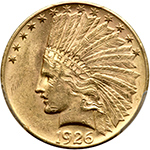 |
1926. PCGS graded MS-61. An untoned coin. Bright luster. A couple of bagmarks on the portrait (PCGS # 8882) .
Estimated Value $700 - 725.
View details and enlarged photos
Check results on similar lots
| Realized
$752 |
Lot 1954 |
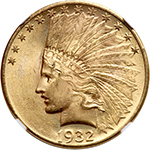 |
1932. NGC graded MS-65. Star. A frosty coin with a hint of gold tone. Most examples of this issue are lustrous and easily certified, since the 1932 date had little or no time to circulate; many were brought back from European bank hoards 30 to 40 years later. All the evidence from this piece shows that from tip to toe it is an untoned gem with impressive mint brilliance. The luster, we should add, includes spotless surfaces. This is a strongly struck example, also, with outstanding detail to all the important high points such as Liberty�s hair and the feathers. A bold, sharp eagle completes the picture. Where sometimes you might see the add on "with the possible exception of these regions (standard for the issue)", we are thrilled to say that no such add on is required on an always sharp 1932-dated Eagle (PCGS # 8884) .
Estimated Value $2,900 - 3,000.
View details and enlarged photos
Check results on similar lots
| Realized
$2,703 |
Lot 1955 |
|
A pair of 1911 and 1926 $10 Indians. Sharpness of EF. Both coins were cleaned and perhaps worn as jewelry. Lot of 2 coins.
Estimated Value $1,000 - 1,050.
View details
| Realized
$1,146 |
Lot 1956 |
|
A trio of $10 Indians. Sharpness of XF. Consists 1908-D Motto, 1911, and 1932. All have minor problems. Lot of 3 coins.
Estimated Value $1,700 - 1,800.
View details
| Realized
$1,998 |
|
|